Disputed islands are part of Pangasinan –ASNA awardee
WEST PHILIPPINE SEA ISLANDS
LINGAYEN—A little known fact in the continuing reclamation and sovereignty issue with China in the West Philippine Sea is the revelation of ASNA Outstanding Pangasinan awardee that the contested islands and shoal are part of the province of Pangasinan.
The 87-year-old book author Dr. Cecilia Daranciang said the two island groups, Paracel Islands and Spratlys Islands, and the shoal, Scarborough or Panatag “are still, until now” part of the province.
“If you examine the folklore of Pangasinan, the Spratlys Islands are composed of many stones, which are like pouches and bars, named after fishes of Pangasinan as siwi-siwi, alalo, bangus, lapu-lapu, hasa-hasa and ayungin,” she said.
The last two types of fish are still present according to fishermen who fish at the shoal, she added.
Further, the culture and arts enthusiast said proofs of her claim were the presence of Ibn Batuta and Princess Urduja in the islands in the middle of 14th century.
Ibn Batuta, according to Daranciang, “is considered the Marco Polo of the East,” who recorded his travel and confirmed the presence of Princess Urduja, the legendary Pangasinan warrior.
“The Spaniards tried to burn all structures and documents because they wanted to show that Filipinos were barbaric and the ones who were analyzing the life of history of (Princess) Urduja are using Spanish books which never mentioned about Urduja, so Urduja is named in mythology,” she said
Daranciang said she has not contacted anyone yet in the national government in regard to her research, but will willingly testify if called.
The Paracel Islands is being claimed by Vietnam and China while Spratly Group of Islands is being claimed by China, Philippines, Vietnam, Malaysia, Brunei and Taiwan.
Scarborough shoal has been exclusively under the control of the Chinese since 2012.
Daranciang is now working on her book on the subject, based on her research using ethnographic triangulation tool.
She said her primary source were the things she stored in her repertoire which she has gathered since aged five.
“Subconsciously, I was working without knowing what I was doing and the use of what I was doing,” said Daranciang who wrote more than 20 books, mostly on Pangasinan history, and culture, and arts. (Johanne Macob)
Share your Comments or Reactions
Powered by Facebook Comments









